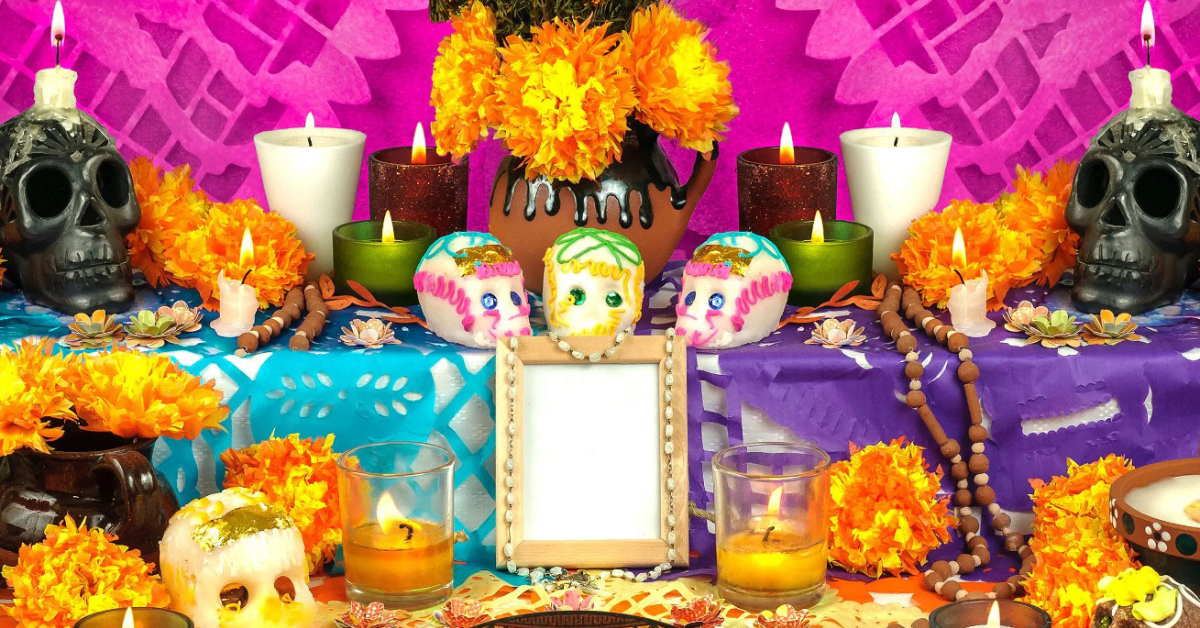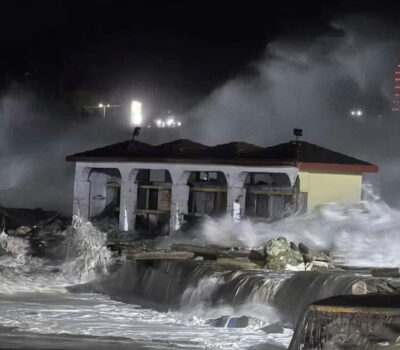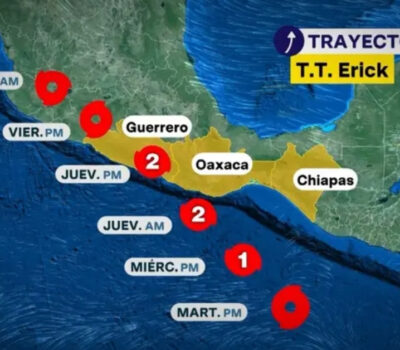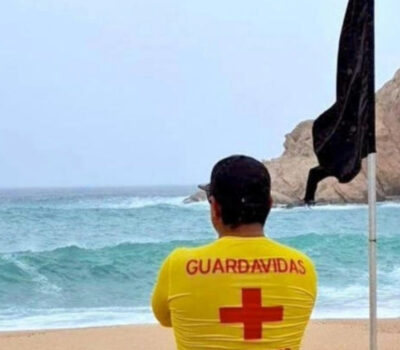In Mexico, November 1 and 2 have become days of party and celebration. It is believed that during these dates, the dead have permission to enjoy and spend time with their loved ones. They cross the Mictlan and arrive with the mortals to share food and drinks, and receive two days of tributes. They call it Día de los Muertos, or Day of the Dead in English.
The offering, also known as the altar, is one of the main elements of this celebration. With the favorite meals, snacks, and beverages of the deceased, the living pays respect and venerates the one who has left. As part of the beliefs of the Mexicans, it is common to hear that after those days the food that was placed in it loses its flavor and smell because the visitors have consumed it.
On many occasions, the offerings or altars for the dead are placed in the home of relatives or friends of the deceased, and on others, they are arranged in the tomb of the deceased. “There was no shortage of water, pan de muerto, chocolate, fruit, resins, turkey mole, fermented drinks, black paper roses, and of course, a lot of cempazuchil, to end up giving free rein to the feast, to drink” according to the 19th-century journalist, Ángel del Campo Valle, better known as Micrós.
In addition, depending on the relative to whom it is addressed, specific dishes are designated that were to the favorites of the deceased. It is also common to see chocolate and sugar skulls, salt, chopped paper, incense, fruit, clay dogs, and photographs of relatives or friends to whom the offering has been placed. In many homes, they have crosses or some image of saints “so that the devil does not touch their things” according to the testimony of Rosalba Mendoza, a resident of La Santísima in Xochimilco, collected by the National Institute of Indigenous Peoples (INPI). It is also customary to place toys and sweets on the altars waiting to receive a child who has passed.
Read the official PVDN guide to Day of the Dead in Puerto Vallarta
The origin of the Day of the Dead Altar
Since pre-Hispanic times there were offering rituals for crops and ancestors. The Nahuas considered sowing in the same way that they did death: a constant cycle that could not exist without the other. The fruits had to be harvested in order to sow again; however, the harvest months were feared that crops would die as the time of transition between drought and abundance. As a tribute to continue the cycle, sacrifices and offerings were made in order to share the fruits with the ancestors. Among the main elements that the offerings had, cocoa, money, wax, birds, seeds, and fruits.
As part of this union between harvest and death, the indigenous people had two dates in which they venerated both. According to Fray Diego Durán, their names were Miccailhuitontli or Fiesta de los muertecitos and Fiesta grande de los muertos. The first took place in the ninth Nahua month (equivalent to the month of August in the Gregorian calendar) and the second took place in the tenth month. The Fiesta de los Muertecitos still takes place in the Magdalena Contreras city hall on November 1. On the Acoconetla mountain offerings are left with pots and jugs with milk, atole, chocolate, and sweet bread.
To this was added that during the conquest, the traditions of All Saints and Faithful Departed arrived in America. These days in which the Maccabees were commemorated and later focused on offering prayers for forgiveness, also had a ritual in which relics, remains, and treasures were exhibited in churches and convents.
According to the sociologist and anthropologist José Eric Mendoza Luján, during the conquest, the locals changed their dates to appear to celebrate Christian traditions. “According to the Catholic calendar, November 1 is dedicated to All Saints and November 1 to the Faithful Departed. However, in the popular tradition of a large part of the Mexican Republic, day 1 is dedicated to deceased children, and day 2 for adults.
When is the offering placed?
According to the compilation of the National Institute of Indigenous Peoples entitled The festival of the dead in Xochimilco, the offering or the altar of the dead must be placed according to the day that the deceased are remembered. “If it is for someone who died in an accident, they are placed on October 28. To children on October 31 and to adults on November 1”.
In some regions, the offering is placed in the morning but it is more common for it to be ready at eight at night, before the Calaverita is distributed to the children who go out to ask for sweets or money on the night of November 1. It is believed that at this time the deceased arrive. In many homes, after the offering is placed and during these days, the doors of the house are not closed.
Elements of the Day of the Dead offering
Cempasuchil (marigold flowers)
The cempasúchil flower is used because in pre-Hispanic times it was believed that its smell attracted the dead, according to Andrea Rodríguez, a researcher at the National Autonomous University of Mexico (UNAM) and a specialist in the study of pre-Hispanic gardens in an interview for the BBC.
Many residents place paths of defoliated flowers so that the deceased can find the route.
Water
According to the INPI, the water is available with the intention of quenching thirst after the spirit’s journey. It also symbolizes the purity of the soul and the light on the path.
Incense or incense
It is placed to purify the place designated for the offering.
Salt
With the intention that the souls are not corrupted, the salt has the role of purifying the dead.
Candles or waxes
The flame is the guide that allows the souls to return to their homes. They mean the light that gives hope. On many occasions a candle is placed for the deceased, other people have the custom of accommodating four waxes representing the four cardinal points and if the deceased has just died, they usually use purple candlesticks as a sign of mourning.
Xoloitzcuintle puppy
It is used to represent the task that dogs had in the Nahua cosmogony. When dying, the Nahuas faced Itzcuintlán, the first of the nine strata of the underworld. This site was full of xoloitzcuintles dogs that could help humans cross a wide river called Apanohuacalhuia. Only if the human was worthy, the dog helped him. Otherwise, the soul would wander for posterity.
Pan de Muertos
It is thought of as “the body of Christ” but also as a representation of the deceased. The pan de muertos (bread of the dead) vary depending on the region where it is made. In central Mexico, it is distinguished by having little balls of bread that symbolize the bones and skull of the dead.
Sugar skulls
According to information from the INPI, the “small skulls are dedicated to the Holy Trinity, while the large ones are destined for the eternal father.”
Is there an order to place offerings on the altar?
“You start from left to right and the sequence is: first the fruits, then the bread, then the candles or waxes, the food and the copal. The flowers are arranged beforehand in large vases. An offering is added for the soul alone, another for the soul in purgatory, and finally another “for the forgotten souls that no one remembers anymore”, “according to the research carried out by the anthropologist Isabel Lagarriga Attias in the town of La Candelaria in Coyoacán, Mexico City.
When should the offering be removed?
According to the belief, once the deceased are gone, the living can enjoy the fruits and food. On November 3, the offering is removed and the food or sweets are distributed among neighbors and relatives.
In the end, your altar can be anything you wish that best represents the person you are honoring. Instead of looking at Halloween as the gory holiday that promotes fear of death, celebrate Día de los Muertos and honor the dead and the memories of those who have passed in a positive way. Isn’t that how we all want to be remembered?
In Mexico, November 1 and 2 have become days of party and celebration. It is believed that during these dates, the dead have permission . . .












